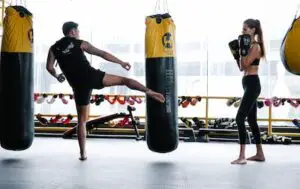Hand injuries are among the most common and frustrating injuries in the sport of boxing. With the constant impact and repetitive stress placed on the hands during training and bouts, it’s crucial for boxers to prioritize hand injury prevention. By implementing proper techniques, using protective gear, and following specific precautions, boxers can significantly reduce the risk of hand injuries and ensure their longevity in the sport.
In this article, we will explore six essential sub-questions about preventing hand injuries in boxing:
What are the common hand injuries in boxing?
Boxers are susceptible to various hand injuries due to the forceful punches delivered during training and fights. Some of the most prevalent hand injuries include fractures, sprains, dislocations, and ligament tears. These injuries can lead to immense pain, swelling, reduced mobility, and prolonged recovery periods. Understanding the common hand injuries is crucial for boxers to identify symptoms early on and take necessary preventive measures.
Fractures can occur in the metacarpal bones, commonly known as the knuckles, or the small bones in the fingers. Sprains involve stretching or tearing of ligaments, which support the joints, while dislocations occur when the bones in the hand are forced out of their normal positions. Ligament tears can result from sudden, forceful movements, causing instability and impairing hand function. By recognizing the signs of these injuries and seeking prompt medical attention, boxers can minimize the impact on their careers.
How can boxers choose the right boxing gloves?
Selecting the appropriate boxing gloves is vital to protect the hands during training sessions and bouts. Factors such as glove weight, size, material, and hand-wrap compatibility should be considered. The weight of boxing gloves typically ranges from 8 to 20 ounces, with heavier gloves providing more padding and cushioning. For training purposes, boxers often opt for heavier gloves to minimize the impact on their hands.
The size of the gloves is also essential, as it should ensure a snug fit without restricting hand movement or blood circulation. The material of the gloves can vary, with synthetic leather and genuine leather being the most common options. Genuine leather gloves are generally more durable and offer better ventilation. It’s important to choose gloves that are compatible with hand wraps, as hand wrapping provides additional protection and support to the hands.
What role does hand wrapping play in injury prevention?
Hand wrapping is an essential step before putting on boxing gloves. Wrapping the hands with proper technique helps stabilize the joints, secures the wrist, and supports the bones and tendons. It provides an additional layer of protection, reducing the risk of fractures, sprains, and other hand injuries.
To effectively wrap the hands, boxers should use hand wraps made of elastic material that provide adequate compression and support. There are several hand wrapping methods, including the traditional method, the Mexican style, and the quick wrap. The traditional method involves wrapping the wrist, the base of the thumb, and each finger individually, creating a secure and supportive foundation for the gloves. Boxers should ensure that the wraps are not too tight, as this can restrict blood flow and cause discomfort.
How can boxers strengthen their hands and wrists?
Building strength in the hands and wrists is crucial for injury prevention. Incorporating specific exercises and training techniques can help boxers develop stronger hands and wrists, making them more resistant to injuries.
Grip strengthening exercises are particularly beneficial for boxers. These exercises can include squeezing a stress ball, using grip trainers, or performing finger curls with dumbbells. By regularly engaging in these exercises, boxers can enhance their hand and forearm strength.
Forearm exercises also play a significant role in strengthening the hands and wrists. Boxers can incorporate exercises such as wrist curls, reverse wrist curls, and pronation/supination exercises to target the muscles in the forearm. These exercises help improve grip strength and enhance the stability of the wrists.
Shadow boxing is another effective technique for hand and wrist strengthening. By performing controlled punches in the air, boxers can engage the muscles in their hands and wrists while also focusing on proper technique. Shadow boxing allows boxers to simulate the movements and impact of punches without the added strain of hitting a target.
What are the proper punching techniques to prevent hand injuries?
Using proper punching techniques is paramount for minimizing the risk of hand injuries. Boxers should focus on correct fist formation, alignment, and wrist positioning to avoid unnecessary strain on the hands.
First and foremost, boxers should ensure proper fist formation. The hand should be wrapped around the knuckles, with the thumb placed outside the fingers for support. The fist should be tight but not overly clenched, allowing for some flexibility upon impact. By forming the fist correctly, boxers distribute the force of the punch more evenly, reducing the risk of hand injuries.
Alignment is crucial for protecting the hands during punches. Boxers should aim to land punches with the first two knuckles, as they are stronger and more resistant to injuries. Striking with the pinky or ring finger knuckles increases the likelihood of fractures or sprains. Additionally, maintaining proper alignment of the wrist throughout the punch is essential. The wrist should be straight and not bent excessively, as this can strain the tendons and ligaments in the hand.
Proper footwork and body mechanics are also crucial in preventing hand injuries. Generating power from the legs and transferring it through the hips and torso reduces the strain on the hands. Boxers should rotate their body during punches, allowing the force to travel through the entire kinetic chain and minimizing the impact on the hands.
How important is rest and recovery for hand injury prevention?
Rest and recovery play a vital role in preventing hand injuries in boxing. Boxers should allow ample time for their hands to heal and recover between training sessions and fights. Overtraining and lack of rest can lead to overuse injuries, chronic pain, and decreased performance.
Incorporating regular rest days into a training schedule is essential for hand injury prevention. These rest days allow the hands and wrists to recover from the stress and impact they endure during training. During rest days, boxers can engage in other forms of exercise or focus on active recovery techniques such as light stretching or using a foam roller to improve blood circulation and reduce muscle tension.
Additionally, applying ice therapy after intense training sessions or bouts can help reduce inflammation and alleviate any minor discomfort or swelling. Ice packs or ice baths can be used to cool the hands and wrists, promoting faster recovery.
Heat therapy can also be beneficial for hand recovery. Applying a warm compress or using a heating pad can help relax the muscles and increase blood flow, aiding in the healing process. Heat therapy is particularly useful before training sessions to warm up the hands and prepare them for exercise.
Performing regular hand stretches can enhance flexibility and prevent stiffness in the hands and wrists. Simple stretches, such as wrist flexion and extension, finger stretches, and hand rotations, can improve range of motion and reduce the risk of injuries.
Conclusion
Preventing hand injuries in boxing is crucial for the long-term success and well-being of boxers. By understanding the common hand injuries, selecting the right equipment, practicing proper techniques, and prioritizing rest and recovery, boxers can significantly reduce the risk of hand injuries and ensure their continued participation in the sport. It is essential for boxers to implement these preventive measures consistently throughout their training and competitive journey to safeguard their hands and maximize their potential. By taking proactive steps to protect their hands, boxers can enjoy a sustainable and injury-free boxing career.





